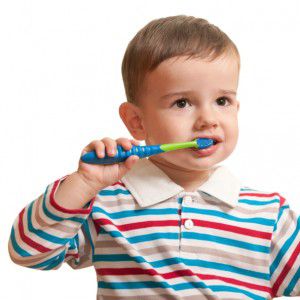Teeth have natural dips or grooves in them, known as pits and fissures. It’s all very groovy in one sense, but when it comes to keeping your children’s teeth clean and free of cavities, pits and fissures aren’t groovy at all.
Pits and fissures house bacteria and other substances which can cause tooth decay in children, and these grooves can’t always be properly cleaned with a normal toothbrush. Thankfully dentists have developed pit and fissure sealants which can fill and seal the grooves in children’s teeth and prevent bacteria getting in. They make teeth easier to clean and reduce the risk a child will experience tooth decay.
Fissure sealants are recommended for filling the adult or primary teeth of children who have a high risk of developing cavities. And even children who brush and floss regularly can be considered high risk, depending for example on the amount of fluoride they consume and the shape of their teeth (particularly the groovy parts).
 |
Children are not always able to clean their teeth properly with a normal toothbrush. |
 |
Pit and fissure sealants may make it easier for your child to clean their teeth properly, especially if they have deep and narrow pits and grooves in their teeth. |
 |
Dentists may recommend sealants for your child even if they brush and floss their teeth regularly. |
Kid’s teeth are often groovy, baby
Kid’s teeth are often groovy. There are two types of grooves that may be found in the biting surface of teeth, known as pits and fissures. As the name suggests, pits are small indentations (pits) in the tooth’s dental enamel (the hard covering which protects the tooth from bacteria and other nasties).
Fissures are the grooves which form naturally and give shape and texture to the biting surface of ‘chewing’ teeth at the back of the mouth (called molars and premolars). They typically only affect the ‘chewing’ teeth, but in a minority of exceptionally groovy children the ‘biting’ teeth at the front of the mouth (called canines and incisors) may also have fissures. While teeth fissures are visible to the naked eye as grooves running through the teeth, the bottom-most point of the fissure cannot be seen. It may be so narrow that the bristles of a toothbrush are too wide to enter and clean the grooves.
 Brushing teeth just doesn’t cut it
Brushing teeth just doesn’t cut it
No matter how thoroughly your child cleans and flosses their teeth, completely removing bacteria and other nasties from fissures is impossible if the grooves are too narrow. The pits and fissures in teeth which cannot be cleaned provide shelter for bacteria, making it much easier for them to take up permanent residence in your child’s mouth and cause tooth decay.
Dental cavities are five times more likely to occur in pits and fissures than in the edges which border the spaces between teeth, as the spaces can be cleaned with dental floss to remove bacteria which might otherwise cause tooth decay. Research shows that the vast majority (84%) of all holes in kids’ teeth occur in the pits and fissures. However, research also shows that the likelihood of your child developing holes in these places can be substantially reduced by filling the grooves.
Teeth protected with fissure sealants are 22 times less likely to decay than unprotected teeth. Now those are good odds, but only around 20% of children have fissure sealants. Dentists believe that if sealants were more common, tooth decay in children would be less common.
What’s in a fissure seal?
Fissure sealants made from materials called glass ionomer cement or composite resin can be used to seal up these pesky grooves. Research shows that these substances are not only effective in preventing cavities; they’re also safe to place in a child’s mouth. The sealants form a mechanical barrier which prevents bacteria and other nasties entering the grooves and considerably reduces the likelihood of cavities forming in the grooves.
Ultimately the seals prevent tooth decay. One year after the sealants have been put in place, a child is 80% less likely to get a cavity. After two years they are 70% less likely to have a cavity, compared to children who do not have fissure sealants.
Which kids need fissure sealants?
Not all children require fissure sealants. As a general rule, they’re recommended for filling the molars of kids with a high risk of tooth decay, such as those who have already had a couple of dental cavities filled and those who lack fluoride in their drinking water.
There are also features of the teeth that can determine whether or not fissure sealants should be applied. Permanent teeth (second set of teeth or adult teeth) which have just emerged through the gums, and those with grooves which are particularly deep or narrow, are most likely to benefit from fissure sealants. If your child requires fissure sealants, it’s recommended that they’re put in place as soon as possible after their permanent teeth emerge through the gums.
 Which kids do not need fissure sealants?
Which kids do not need fissure sealants?
Teeth which are still breaking through the gums into the mouth should not be sealed, nor should teeth that have already developed cavities. However, rest assured that that if a fissure sealant is inadvertently placed over a small area of tooth decay, research has shown the sealant will prevent rather than encourage further decay; it seems that bacteria find it much harder to live and cause tooth decay under a sealant than when they are exposed to saliva and the normal environment of the mouth.
If a child’s adult teeth have been in place for more than 4 years and haven’t experienced decay, they won’t need to be sealed. Your dentist can advise you on whether your child has the type of teeth which will benefit from being sealed.
 |
Be aware of risk factors for tooth decay, such as having previously had dental cavities and drinking water which does not contain fluoride (e.g. bottled mineral water rather than fluoridated tap water). |
 |
Take your child to the dentist as soon as their adult teeth emerge through the gums- if they do need fissure sealants, this is the best time to place them. |
 |
Fissure sealants cannot be put in place until the adult teeth have broken through the gums. |
 |
Don’t be concerned about teeth decaying under a fissure sealant- if a tooth has already started to decay, placing the fissure seal will slow down the decaying process. |
 |
Talk to your dentist for more advice about whether fissure sealants are appropriate for your child. |
Types of sealants
There are several different styles of pit and fissure sealants, for example clear or opaque sealants. Your dentist can advise you about the pros and cons of each sealant style, and allow you to decide which is most suitable for your child’s teeth. Once you’ve decided, the fissure sealants only take about 10 minutes to put in place and can be applied by a dentist, dental therapist or dental hygienist.
 |
Talk to your dentist about the benefits and disadvantages of different types of fissure sealants. |
 |
If your child needs a sealant, choose the type of sealant which you think is best for your child’s teeth. |
Applying the good stuff to prevent tooth decay
 To place the sealant, your child’s dentist will clean the tooth to ensure there are no particles of food or other contaminants stuck to it and then dry it thoroughly, as the sealant can only stick properly to a tooth that is perfectly clean and dry. Next a chemical which works like glue to ensure the sealant bonds to the tooth is applied. Then the sealant is added to fill the grooves and keep food particles and bacteria out.
To place the sealant, your child’s dentist will clean the tooth to ensure there are no particles of food or other contaminants stuck to it and then dry it thoroughly, as the sealant can only stick properly to a tooth that is perfectly clean and dry. Next a chemical which works like glue to ensure the sealant bonds to the tooth is applied. Then the sealant is added to fill the grooves and keep food particles and bacteria out.
The sealant is allowed to dry, until it is hard and durable. Sometimes the dentist will shine a strong light on the sealant to help it set. Your child’s bite will be checked, and if the sealant has affected the way your child’s teeth press together, it may be necessary to polish away tiny amounts of the sealant to correct this. Once in place, your child’s teeth will have additional protection from decay-causing bacteria for up to seven years.
Long time in the tooth: How long do fissure sealants last?
About half of all fissure sealants placed in children’s teeth stay in place for 7 years, however the other half move or fall out sooner than this and need to be replaced. It’s more likely that fissure sealants will fall out if the teeth have tiny bits of saliva or food caught on them when the sealants are applied, which is why thoroughly cleaning and drying the teeth before applying the sealant is so important.
About 30% of sealants become dislodged and need to be reapplied once. Another 20% of sealants need to be reapplied two or three times. Fissure sealants usually dislodge within 6 months of placement, and if this happens, your dentist will notice during a routine dental check-up. So you’ll need to continue taking your child to the dentist every 6–12 months to check up on the fissure sealants, but this is recommended as part of good dental health for children anyway.
Other complications are rare, and if they do occur are minor. For example a few children find the sealants uncomfortable for their teeth or gums, or are hypersensitive (allergic) to the ingredients in the sealant. But this is uncommon, and for most children sealants are an easy way to protect their teeth and make them easier to clean.
 |
Ensure your child brushes their teeth thoroughly before going to the dentist to have fissure seals applied. |
 |
Continue taking your child for regular dental check-ups (every 6-12 months) once the sealants have been put in. |
Pearly whites: How to keep your kid’s teeth healthy
 It’s important to remember that fissure sealants are not a magic solution to tooth decay. They are just one part of a multi-dimensional dental hygiene routine which should involve brushing and flossing, regular trips to the dentist and avoidance of foods which promote tooth decay. For example, consuming lots of sugary foods and drinks is more likely to cause holes in a child’s teeth than eating healthy options.
It’s important to remember that fissure sealants are not a magic solution to tooth decay. They are just one part of a multi-dimensional dental hygiene routine which should involve brushing and flossing, regular trips to the dentist and avoidance of foods which promote tooth decay. For example, consuming lots of sugary foods and drinks is more likely to cause holes in a child’s teeth than eating healthy options.
But adding fissure sealants to some good old-fashioned brushing and flossing and regular check-ups with the dentist is an excellent recipe for ensuring that your child’s teeth will be pearlers.
 |
Remember that fissure sealants are not a magic solution to tooth decay. |
 |
Ensure that your child continues to brush and floss regularly once their fissure sealants have been put in place. |
 |
Ensure your children avoid foods which promote tooth decay such as sweets and sugary drinks. |
The sealed tooth will set you free
Fissure sealants are a great way to protect your child’s teeth from decay. They are easy and fast for your child’s dentist to put in place, and typically last a long time. Given that more than four in every five cavities occur in the grooves of teeth, it’s not surprising that fissure sealants drastically reduce the chance of tooth decay. Talk to your dentist about fissure sealants, so you can do the best for your child’s chompers.
Download
 |
Download the pit and fissure sealants checklist |
You might also like…
 |
Teething |
References
- Cameron A, Widmar R. Handbook of Paediatric Dentistry. London: Mosby; 1997. (Book)
- Mitchell DA, Mitchell L. Oxford Handbook of Clinical Dentistry (4th edition). New York: Oxford University Press; 2005. (Book)
- Patient education pamphlets: Fissure sealants (brochure). Australian Dental Association; 2009.
- Roberson TM, Heymann HO, Swift EJ Jr (eds). Studervant’s Art and Science of Operative Dentistry (4th edition). St Louis: McGraw-Hill; 2002. (Book)
- National Center of Health Statistics. Plan and operation of the Third National Health and Nutrition Examination Survey (NHANES III), 1988-1994 (PHS publication no. 94-1308). Vital Health Stat 1. 1994;(32):1-407. Available from: (URL link)
- Dental Product Spotlight: Pit and fissure sealants. J Am Dent Assoc. 2002;133(9):1275. (Full text)
- Ripa LW. Occlusal sealants: Rationale and review of clinical trials. Int Dent J. 1980;30(2):127-39. (Abstract)
- Straffon LH, Dennison JB. Clinical evaluation comparing sealant and amalgam after 7 years: Final report. J Am Dent Assoc. 1988;117(6):751-5. (Abstract)
- Leverett DH, Handelman SL, Brenner CM, Iker HP. Use of sealants in the prevention and early treatment of carious lesions: Cost analysis. J Am Dent Assoc. 1983;106(1):39-42. (Abstract)
- Azarpazhooh A, Main PA. Pit and fissure sealants in the prevention of dental caries in children and adolescents: A systematic review. J Can Dent Assoc. 2008;74(2):171-7. (Abstract | Full text)
- Newman M, Takei H, Klokkevold P. Carranza’s Clinical Periodontology. 10th ed. Carranza F, editor. St Louis: Saunders, Elsevier; 2006.
- Gustafsson BE, Quensel CE, Lanke LS, Lundqvist C, Grahnen H, Bonow BE, et al. The Vipeholm dental caries study: The effect of different levels of carbohydrate intake on caries activity in 436 individuals observed for five years. Acta Odontol Scand. 1954; 11(3-4): 232-64.
- Simonsen RJ. Cost effectiveness of pit and fissure sealant at 10 years. Quintessence Int. 1989;20(2):75-82. (Abstract)











